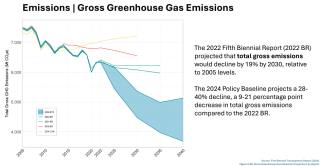Non-CO2 Greenhouse Gas Emission Projections & Mitigation
Non-CO2 GHG Projections & Mitigation
The EPA non-CO2 greenhouse gas (GHG) technical report series provides projected estimates of emissions and technical and economic mitigation estimates of non-CO2 GHGs from anthropogenic sources for 195 countries and for all 50 states in the U.S.
These non-CO₂ GHG datasets provide information that can be used to understand national and sub-national contributions of GHG emissions and mitigation opportunities, and are of particular use to economic and integrated assessment models that evaluate the effect of GHG emissions and the cost and availability of mitigation from the non-CO₂ GHG sectors.
-
Global Non-CO2 Greenhouse Gas Emission Projections & Mitigation Potential

The EPA technical report series, Global Non-CO2 Greenhouse Gas Emission Projections & Mitigation Potential, provides a consistent and comprehensive set of historical and projected estimates of emissions and technical and economic mitigation estimates of non-CO2 GHGs form anthropogenic sources for 195 countries. The analysis provides information that can be used to understand national contributions of GHG emissions, historical progress on reductions, and mitigation opportunities.
-
GHG Emission Projections and Mitigation Data Tool

The accompanying data sets to these reports are also available through the Non-CO2 Greenhouse Gas Data Tool. This is a data exploration tool for querying and visualizing the non-CO2 GHG projections and mitigation assessments compiled in the report.
-
U.S. State-level Non-CO2 Greenhouse Gas Emission Projections & Mitigation Potential

This report provides U.S. technical and economic mitigation estimates of non-CO₂ GHGs from anthropogenic sources at the state-level.
-
Non-CO2 Methodology Report

The full methodology used to develop the emission projections and mitigation estimates is documented in the peer-reviewed EPA report Global Non-CO2 Greenhouse Gas Emissions Projections & Marginal Abatement Cost Analysis: Methodology Documentation.

Recent Applications of Non-CO2 GHG Projections
The 2024 Biennial Transparency Report (BTR), published in December 2024, provides official U.S. Government projections of greenhouse gas (GHG) emissions through 2040. This report includes projected U.S. estimates of emissions of non-CO2 GHGs from anthropogenic sources alongside other CO2 GHG projections.
